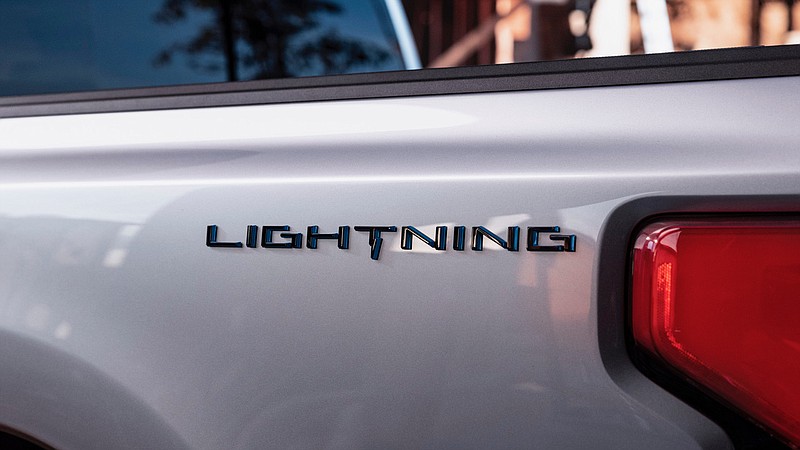DEARBORN, Mich. - Steam-powered cranes raised Henry Ford's 40-foot cathedral of "vertical integration," the Rouge River Complex where generations of workers would turn trillions of tons of ore and sand into millions of cars and trucks.
This week Ford will reveal what may become the Model T of the 21st century, the all-electric F-150 Lightning, which begins production at Rouge River early next year. The event will be one of two high-profile unveilings this week - the other by Kia - that will signify the electric-vehicle tsunami is closer than it appears.
Ford will generate the most thunder Wednesday night with a multimedia show, beginning at 10:30 p.m. CDT, to be broadcast more than 30 ways to a global audience.
The event will originate in Dearborn where workers have installed a 64,000-square-foot projection screen on the Michigan Avenue side of the Glass House, Ford's world headquarters.
The company has been tight-lipped about the screen's purpose, but the timing indicates it will broadcast the same feed that will be sent to traditional media, social networks, YouTube, and 18 physical displays, such as Times Square in New York and Las Vegas Boulevard.
Today, 14 BEVs (battery-powered electric vehicles) are available on the American market. Four are built by Tesla but the best is built by Chevrolet. In the next 12 months, the total will more than triple. A half-dozen startups are trying to elbow into the market, but most models will come from established automakers, experts at building in volume.
Median sales prices will begin to fall not only because of competition, not only because BEVs are cheaper to build, but because automakers are eyeing a much larger market, the middle class. The Tesla Model 3 - soon to be built in Austin - Hyundai Ioniq, Kia Niro, Mini Cooper SE, Nissan Leaf, VW i4 and Chevrolet Bolt (in our opinion, the value leader) all have starting prices less than $40,000.
Ford found early success in the BEV market with the critically acclaimed and hot-selling Mustang Mach-E SUV, but now it is aiming to generate high volume sales with a version of America's best-selling vehicle the F-150.
So far, the Blue Oval has released few details about the Lightning, which was designed from the ground up to be a BEV, not a rejiggered ICE (internal combustion engine) truck.
Early marketing materials from Ford portray Lightning as the next step in the evolution of the F-series. Ford CEO Jim Farley said in a recent press conference that the electric F-150 will have power, payload, and towing capabilities that will meet or exceed those of current gas-powered light pickups.
"Every so often, a new vehicle comes along that disrupts the status quo and changes the game - Model T, Mustang, Prius, Model 3. Now comes the F-150 Lightning," said Farley. "America's favorite vehicle for nearly half a century is going digital and fully electric.
"F-150 Lightning can power your home during an outage; it's even quicker than the original F-150 Lightning performance truck, and it will constantly improve through over-the-air updates."
The auto-writer grapevine guesses the Lightning will begin around $70,000, competitive with an extremely well-equipped F-150.
Hyundai, Kia move on
Korea-based Hyundai is fighting for airtime with two major BEV announcements.
One is that the company and its subsidiary are investing $7.4 billion by 2025 to produce electric vehicles and develop smart mobility technologies, such as hydrogen trucks and robotics technology.
Hyundai plans to work with public and private partners, such as Cummins and the U.S. Department of Energy, to increase hydrogen availability in the U.S. while it develops fuel-cell electric commercial vehicles.
Robot-driven, hydrogen-powered 18-wheelers may be in the future. Last year, Hyundai bought a controlling interest in Boston Dynamics, a mobile robot firm, for $1.1 billion.
Hyundai and Kia have two U.S. factories. The companies plan to roll out a suite of electric vehicles for the U.S. market and the latest investments will give them the ability to deliver a million units a year by 2025.
"One key element of Kia's transformation is transitioning from the internal combustion engine to electrification," said Sean Yoon, CEO of Kia North America. "With our strategic investment in the United States to produce EV models, we are making huge strides to lead the EV market but also increase our contribution to the economies where we do business."
An indication that Kia plans to be a strong player in the BEV market will come at 9 p.m. Tuesday when the company will light up Times Square with the worldwide reveal of the 2022 EV6.
Though Kia and Hyundai both offer a BEV in America - both quite good - both vehicles are reworkings of architectures designed to be ICE vehicles. The EV6 rides on the companies' new Electric-Global Modular Platform.
Modular means the platform can, with minor modifications, be used to undergird a wide array of models. Electric platforms are more commonly referred to as "sleds," because of their basic design - battery pack in the middle, electric motors either front, rear, or both.
The design is what gives the BEV's a terrific advantage in ride and handling. The center of gravity is almost perfect. The low, flat floor allows for greater cabin volume, so a midsize SUVs feels bigger than it is.
Like everything from Hyundai and Kia these days, the EV6 - in showrooms soon - is sensuously designed, technologically advanced, and flawlessly executed. It has a range of around 320 miles, but you can go 60 miles on just 5 minutes of charging.
It can charge other BEVs or work as a home generator.
The dash is all digital, with twin, 12.3-inch curved displays for the gauge cluster and infotainment system. A head-up display in the windshield provides the driver key information.
Kia says the EV6 can for from 0 to 60 in around 3 seconds and tow about 3.500 lbs. Nothing is official at this point but look for prices to start in the $40,000-$50,000 range.



